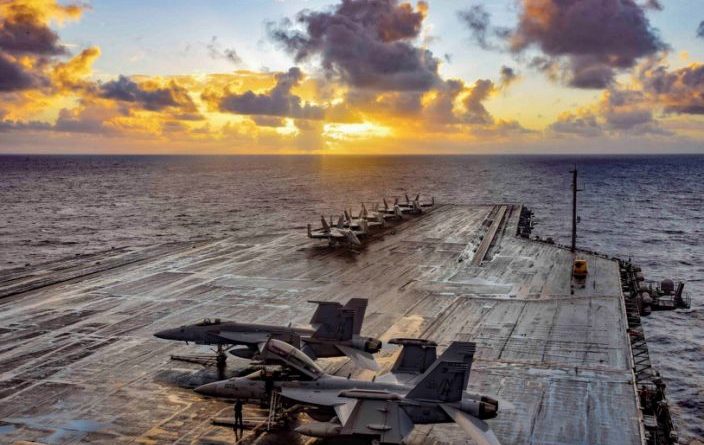THE DAILY PLANET: China Could Not Beat The U.S. Navy -Russia
If U.S. and Chinese aircraft carriers were to clash, the U.S. Navy would win.- Image: Flickr.
.
Sorry China, Not Even Russia Thinks You Could Beat The U.S. Navy
.
Here’s What You Need To Remember: The smaller Chinese carriers, about half the size of their U.S. counterparts and carrying about half the aircraft, would depend on submarines, land-based H-6K patrol aircraft and satellite surveillance to locate the American carrier force. In contrast, the U.S. carriers would have their own onboard E-2 Hawkeye airborne radar aircraft and EA-18 electronic warfare planes, as well as AWACS land-based radar aircraft.

China’s Nine Dash Line


If U.S. and Chinese aircraft carriers were to clash, the U.S. Navy would win.
And who makes that prediction? A Russian military expert.
Konstantin Sivkov, a member of the Russian Academy of Rocket and Artillery Sciences, argues that superior U.S. reconnaissance capabilities would trump China’s advantages in hypersonic missiles.
Sivkov lays out a sort of wargame for an America vs. China carrier clash that seems based on the World War II carrier battles between America and Japan, particularly the Battle of Midway. Those battles tended to be nail-biting, knife-edge affairs where victory or defeat rested on which side first spotted the other side’s carriers, and then dispatched an airstrike against the vulnerable flattops.
“The key role that determines the course and outcome of hostilities at sea in modern conditions is played not so much by the power and quantity of strike weapons, but by the capabilities of the reconnaissance system on an ocean theater of operations,” Sivkov writes in the Russian defense publication Military-Industrial Courier. “Surpassing the enemy in this respect, the U.S. Navy is able to significantly level the superiority of the Chinese in hypersonic anti-ship missiles.”
While the U.S. has by far the greatest carrier fleet in the world, China already has one carrier, is almost ready to sail another, and may eventually build a half-dozen or more to assert Chinese power in the Western Pacific and beyond. That leaves Russia, a traditional land power that has just one carrier (now out of commission after a dockyard accident), as something of an interested bystander in carrier warfare.
Sivkov assumes that because China lacks power projection capabilities such as overseas bases, the battle would be fought closer to bases within 500 to 1,500 kilometers from the coast of China (or a base in, say, the Indian Ocean if China manages to obtain one from a friendly state). Presumably outgunned in a purely carrier battle, the People’s Liberation Army Navy will seek an engagement within range of its hypersonic missiles launched from land and by bombers.
.

“When the Americans try to impose a battle at great distances from coastal bases, the Chinese will strive to evade it, and if this is not possible, they will try to solve the problem of the quickest withdrawal of their forces from fire, deflecting the enemy’s attacks and inflicting their own,” Sivkov argues.
The smaller Chinese carriers, about half the size of their U.S. counterparts and carrying about half the aircraft, would depend on submarines, land-based H-6K patrol aircraft and satellite surveillance to locate the American carrier force. In contrast, the U.S. carriers would have their own onboard E-2 Hawkeye airborne radar aircraft and EA-18 electronic warfare planes, as well as AWACS land-based radar aircraft. Sivkov believes that U.S. carrier group defenses would neutralize Chinese submarines and patrol planes, keeping them from fixing the task force’s location, while Chinese satellites would pass overhead too swiftly to maintain continuous contact. Meanwhile, U.S. aircraft and submarines, would find the Chinese force, while the American subs would attrit the Chinese fleet with anti-ship missiles.
While Sivkov doesn’t detail his methodology, he does point to “quantitative estimates” that show that the Chinese battle fleet could only obtain a rough location of American ships, while the Americans would have a much better fix on Chinese ship locations.
.

“At this stage of the battle, the parties will already suffer certain losses,” Sivkov writes. “The Chinese may lose one or two submarines, a surface ship, two or three reconnaissance aircraft, and two or four fighter jets. Americans are less likely to lose one submarine, as well as one or two scout planes and two to four fighters.”
Now comes the crux of the battle. In this scenario, Sivkov estimates that Chinese carrier could only attack with perhaps a half-dozen aircraft, while the rest are retained for defensive combat air patrol. These strike planes will launch anti-ship missiles that might disable or sink a couple of U.S. destroyers on the carrier group’s outer screen. But the U.S. carrier can muster a strike force of 30-plus aircraft, which will destroy some Chinese escorts. To destroy the Chinese carrier, the American flattop would need to launch as second strike.
Meanwhile, four or five Chinese destroyers will try to advance into missile range of the American task force, with each ship firing 16 YJ-18 missiles each, a 6-plus missile salvo that destroy the U.S. carrier. The U.S. will try to advance the carrier escorts to head this off, and use the carrier’s air wing to try and destroy the Chinese surface ship threat.
.

“Modeling the situation at this stage shows that the Chinese group has a good chance to reach the line of attack with a loss of up to 40 to 50 percent of its potential,” writes Sivkov. “A missile salvo of 30 to 40 YJ-18 anti-ship missiles, taking into account the possible weakening of the American defenses after the previous hostilities, will put the American aircraft carrier out of action with a probability of 20 to 30 percent. The effectiveness of the second strike by U.S. carrier-based fighter jets (about 24 aircraft) against a Chinese aircraft carrier is estimated at 40 to 50 percent.”
Sivkov assumes that at this stage, the Chinese force will withdraw, while the American force will pursue and try to mount one last air strike. “Bottom line: the Chinese aircraft carrier will be severely damaged and disabled, or even sunk, along with four to five guard ships, one or two submarines and more than half of the carrier-based aircraft,” Sivkov concludes. The U.S. carrier group will lose “two to three warships and 17 to 20 percent of the carrier-based aircraft. The American aircraft carrier will receive relatively little damage or none at all. In other words, the PLAN carrier group will be defeated and lose the ability to continue fighting. The U.S. carrier group will emerge from the collision only slightly weakened.”
Whoa. This is a busy scenario, with a lot of assumptions in this scenario. For example, it seems to assume a battle between a single Chinese and a single American carrier with their respective escorts, rather than multi-carrier operations. Assuming that Chinese submarines and land-based aircraft would be neutralized by American defenses seems a big assumption, though a necessary one if the U.S. is assumed to operate within range of Chinese land-based defenses.
.

Also interesting is the Russian analyst’s assumption that 21st Century carrier battles will be replays of the World War II carrier battles of the Pacific, where land-based aircraft and submarines were bit players, and the real fighting was between the Japanese and American carriers themselves. But long-range ship-killer ballistic missiles, land-based bombers armed with hypersonic missiles, ultra-quiet submarines and satellite reconnaissance may change that equation.
by Michael Peck
Michael Peck is a contributing writer for the National Interest. He can be found on Twitter and Facebook. This article first appeared last year.
.
More From The National Interest:
Yes, America Has a ‘Ninja’ Missile
How China Could Sink a U.S. Navy Aircraft Carrier
How the F-35 Stealth Fighter Almost Never Happened
Russia Has Missing Nuclear Weapons Sitting on the Ocean Floor
.
.


SIGN UP TO RECEIVE OUR EMAIL
.
The most important news of the day about the Earth and the Universe.
email us: [email protected]
6.23.2020
.











